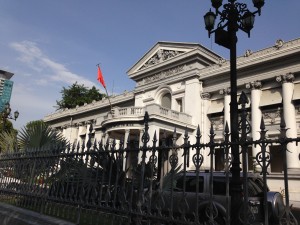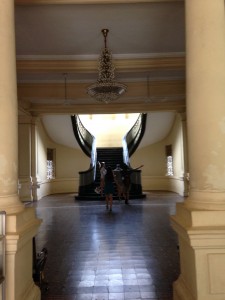As I walked through the gate of the Ho Chi Minh City Museum, I was awed by the grand French classical Baroque architecture. An elaborately decorated façade with Greek motifs and floral patterns confront the viewer. Symmetrically placed columns focus the audience’s eye on the entrance, a semi circular, roofed area at the center of the two-story building. This lavish building has been controlled by a number of different governing bodies. It was built by the French, then passed to the State of Vietnam, the Republic of Vietnam, and now, present day communist Vietnam. Under the various leaders, the building has served a number of different functions from the Museum of Commercial Trade to a palace for the Premier of the State of Vietnam and Republic of Vietnam. (*Note: None of this information is given in the museum, but was researched following the visit.)
Today, the Vietnamese flag, with the communist red and yellow colors, dangles off the second floor balcony in front of the entrance. The symbolic flag reclaims the space – declaring the building once and for all a part of Communist Vietnam. In doing so, Vietnam reasserts its dominance over the imperialist rulers of the past. The building, functioning as a historical museum, offers the opportunity to tell a history of Vietnam from the Vietnamese perspective; just as they have taken back the building from foreign invaders, they take back their history through this narrative. Exhibits include information on the struggle for independence, archeological artifacts, ceramics, old city maps, and the city as a center of trade.
However, as much as the building works to reclaim the history and the space, the effort seems incomplete. It would seem that the extravagance of the building would work to elevate the information and history inside the museum; but instead it exposes the contradiction between the triumph over the past and the problems of modern day. In the lobby atrium, a chandelier hangs from the second floor ceiling and a wide central staircase with smooth, varnished banisters invites visitors upstairs. But when the audience peels off to one of the side rooms where the exhibits are, paint chips off the wall, the rooms are poorly lit and the floors are dirtied. When I was there, there were only five other people in the museum. The Vietnamese had reclaimed this French space to celebrate their own history, and yet it showed the signs of decay. The space completely loses the sense of triumphant glory that the lavish façade with flag and atrium portrays.
The crumbling interior is also a metaphor for the unresolved and multi-narrative history that the exhibit on Vietnam’s independence tries to plaster over with nationalistic and triumphant tidings. The room that catalogues the American War focuses on the heroic North’s efforts against the Southern “puppet” regime. They tell the story through a military history with artifacts like the uniforms that soldiers had worn or cans they had eaten out of. It highlights the heroism of the troops – without any mention of the dissenting views that have more recently surfaced about the war effort amongst Northern soldiers. The exhibit celebrates the success of units from Cu Chi winning battles and photographs of the liberation of the Reunification Palace. While the museum is located in what once was the capital of the Republic of Vietnam, the only mention of this state is its role as a “puppet government.” There is no mention of Southern Vietnamese people who did oppose the Vietcong or what happened to them post Vietcong victory. Instead of confronting this difficult history, the museum’s narrative ignores and supersedes those stories. It silences the people and history of the city that the museum is supposed to be about.
This choice to leave out certain parts of the story echoes the neglect that the interior of the museum faces. While there may be an exterior portrayal of dominance and unification, a closer look inside will reveal the severely cracked history that is slowly starting to surface in other parts of Vietnamese society.


